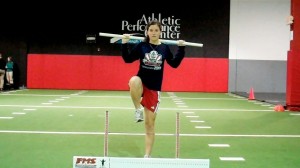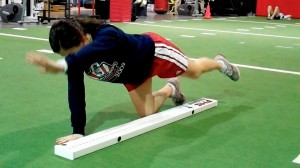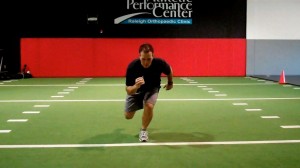Brian Schiff’s Blog
Injury Prevention, Sports Rehab & Performance Training Expert
I am currently working to attain my transitional doctorate in physical therapy (tDPT) at Northeastern University. As I continue to work full time as a clinician, it has been really cool to apply the learning with my current caseload. At this time, I am in a motor control class that is both fascinating and challenging. In week three, we examined pain and the impact it has on neuroplasticity (the brain’s ability to adapt or change).

In the sports medicine realm, I generally think many practitioners solely focus on the musculoskeletal system or physical impairment. As such, interventions are developed around tissue constraints, ROM deficits, weakness, etc. Too often, we look past the power and impact of the brain and how it plays a vital role in healing and return to play. For some patients, there is a maladaptive response to injury/surgery and a hypersensitivity of the central nervous system or central sensitization that occurs. Pelletier (2015) notes that structural and functional changes can occur. (1)
Two critical concepts to consider here are:
- Sensory amplification – sensory and motor representations change resulting in perceptual changes in body image, motor control changes, and even a persistence or amplification of pain
- Experience dependent plasticity – patient’s response to pain is related to prior experience and may experience maladatpive imprinting where the pain outlasts the physical insult
Kleim (2008) gives a great lesson on experience dependent plasticity and states that learning is essential for the brain to adapt to damage self taught behavioral changes can be maladaptive or positive and specific forms of neural plasticity and associated behavioral changes are dependent on specific kinds of experience (2). While one would assume that chronic pain is rare in athletes, I would counter and say it is probably just overlooked as we tend to expect athletes to “push through the pain” because of the driven culture we live in. Coaches, parents and even teammates can affect the mindset around injury and recovery.

So, I just returned from the Combined Sections Meeting for the APTA that was held in Indianapolis. There was lots of great networking and presentations to be sure. I attended sessions on ACL rehab/prevention, femoroacetabular impingement, elbow injuries in throwers, running gait analysis, and shoulder plyometric training with the legendary George Davies. I thought I would give you my top 10 list of helpful nuggets I picked up over the weekend in no particular order of importance.
1. Performing upper body plyometrics has no effect on untrained subjects so don’t waste time putting it into the rehab program, where as it does benefit trained overhead athletes. The one caveat is it also increases passive horizontal external rotation so keep this in mind when working with athletes who have shoulder instability.
2. A new study coming out in 2015 in AJSM revealed no major differences in throwing kinematics between those following UCL reconstruction (Tommy John) and age-matched controls. This is good news for those worried about pitching mechanics after the procedure.
3. According to Dr. Reiman at Duke, the orthopedic hip exam does a better job of telling us they do not have a labral tear than it does telling us they do have an intra-articular problem. The tests have poor specificity. In fact, he goes on to say that the “special tests are not that special.” That brought a chuckle from the crowd including me. Bottom line – we are not really able to conclusively say “yes you have a labral tear based on my exam today.
4. Reiman also feels we must consider look for mechanical symptoms during the lowering portion of the Thomas test, while considering the fact that fat pad impingement may cause anterior hip pain as opposed to joint pain. Again, things are not always as they appear in the “FAI” crowd so we need to take a great history, look at the classic tests and also see how squatting and loading affects the hip.
5. More experienced pitchers do not drop the glove side arm, but instead tend to move their body toward the glove to conserve angular momentum and overcome small moments of inertia. Less experienced pitchers rotate their trunk sooner in pitching cycles whereas pitchers who threw at higher levels rotated later and produced less torque at the shoulder. Consequently, many players with higher elbow valgus torque and distraction force at the shoulder rotate too early.
I wanted to make everyone aware of two courses that I am presenting in the next 2 weeks in conjunction with Allied Health Education:

The first is a (2) hour webinar on Current Concepts in the Recognition and Treatment of Femoroacetabular Impingement tonight, August 23 from 8-10 PM. The course is intended for PT’s, PTA’s and ATC’s looking for an in-depth presentation on the condition and its management. Click here for more information.
In addition, I am scheduled to present two (1) day seminars on “Fit Knees” in Greensboro, NC on Sept. 7 and Richmond, VA on Sept. 8. This lecture/workshop event will feature my evidence based approach to injury prevention and rehabilitation for knee osteoarthritis, running injuries and ACL injuries.
The material presented in this seminar is intended to help identify knee dysfunction and implement safe and effective rehab, corrective exercise and training strategies tailored to meet the needs of each client. Attendees will learn how the presenter utilizes the FMS, Y-Balance test and other screening tools to determine limb asymmetry and imbalances. Additionally, participants will learn how to use assessment and current research to create effective training programs, facilitate the rehab process and guide post-rehab decision making. Click here for more information.
If you have further questions, feel free to post them on the blog.
Over the past several years, the trend in the health and fitness industry has been toward injury prevention and movement screening. Gray Cook and Lee Burton have given us the FMS. More recently, the Y-Balance test has emerged as another tool to assess asymmetry in the upper and lower quarter.
I am currently FMS certified and planning to attend the SFMA course next month in Durham. I routinely incorporate the FMS in both our rehab and sports performance work at the APC. I like many things about the screening exam. It provides a consistent tool to assess baseline movement and record asymmetry on a simple 4 point scale scale. It also has been shown to have good intra and inter-rater reliability. Click here for a recent study published in the Journal or Orthopaedic & Sports Physical Therapy.
For those unfamiliar with the screen, it is 7 tests scored on a 0-3 scale as follows:
- 0 = pain
- 1 = unable to perform the movement pattern (or perform with marked dysfunction)
- 2 = performs the movement with a mild compensation
- 3 = performs the movement correctly
I would say on average, most of the athletes I screen score between a 12 and 15. My highest score was a 19 (9 year old gymnast) and my lowest was a 9 (NFL lineman). As screeners, we are charged with uncovering asymmetry and faulty movement patterns. What do you see in the following picture?

Clearly, the dowel is not level, thus we score it a 2. She also had some ER in the right leg when stepping over the hurdle. She was a symmetrical 2 on the hurdle step test. This is a Division I soccer player who scored 17 on the exam.
Most of the movements seem straightforward. However, many question what the rotary stability test measures with respect to the ideal 3 score (ipsilateral movement)? It assesses an unnatural movement pattern to be sure. This athlete failed miserably on the ipsilateral pattern but scored a solid 2 with the contralateral pattern.

I have yet to test someone who can score a legitimate 3. I have seen some get a 3 on one side and 2 on the other (asymmetrical and a red flag in FMS land). As one who naturally questions things, I find myself questioning how many are truly capable of scoring a 3.
I just finished presenting at our our second ACL Symposium of the year at the Athletic Performance Center last Saturday. Rehabbing and training female athletes has been a passion of mine for some time. Over the years, I have also developed a love for research and reading it, particularly studies on the ACL.
In my practice, I have incorporated jump landing, single leg training and deceleration based training for some time. While we all know females are 3-8 times more likely to suffer an ACL injury than males, we have not isolated the exact reason why. Researchers have offered some clues such as: wider pelvis, narrow femoral notch, smaller ACL, ligament dominance, limb dominance, natural laxity (hormonal factors), wider Q angles, and faulty muscle firing patterns to name a few.
Many of the structural factors are beyond our control. So, as practitioners, we must focus on the training. Consider the following study just published in the August 2011 edition of the American Journal of Sports Medicine that basically reveals females develop peak valgus moments during deceleration during a drop landing maneuver, whereas males develop peak valgus forces during acceleration on the way back up:

Drop Landing
This article adds more evidence that females recruit and fire their muscles very differently than males. More importantly, it reiterates that we as coaches, therapists and S & C professionals need to be working on deceleration mechanics. I believe this starts with simple soft two legged drills such as:
- Small squat jump and holds
- Box drops and holds
- Forward line jump, stick and hold
- Lateral line jump, stick and hold
- 90 degree jump turn, stick and hold
In addition, one of my favorite drills is a single leg forward leap (hop) and stick working on deceleration. The athlete stands on the right leg and then pushes off forward landing on the left leg. Coaching the athlete to land softly on a bent hip and knee while avoiding valgus is important. I usually perform 2-3 sets of 5 reps on each side. Cueing with a mirror, auditory corrections and tactile cues are useful in encouraging proper form.

SL Stick (start)

SL Stick (finish)
It is important to keep in mind that the majority of non-contact ACL tears occur between 0 and 30 degrees of knee flexion. They also typically involve deceleration (landing, jump stop or change of direction), planting or cutting. For this reason, deceleration training must also involve programming for agility and change of direction.
On Saturday, I led the break-out session on deceleration training and covered a few key exercises I use with my athletes. These drills are layered on one another and the basic ones I begin with are:
- Stops – I have athletes accelerate out and then decelerate to a controlled two legged stop after 10-20 yards. Keep in mind allowing for a longer run will allow the athlete to gradually slow down, while decreasing the distance increases intensity and force on the knees. I coach breaking down with small “pitter patter” steps versus a sudden hard stop.
- 2 cone lateral shuffle stops – the athlete shuffles over 5-6 yards and then stops with good hip, knee and foot alignment working to keep the shoulders inside the knees (inside the box). I progress to multiple cone shuffles to increase intensity and maximize repetitive deceleration.
- Pro-agility drills – 3 cones are placed 5 yards apart and I combine linear and lateral movements between the cones layering #1 and #2 above in a continuous pattern to work on acceleration/deceleration combos and change of direction
- Y drill (4 cones) – the athlete runs forward to a cone 5-15 yards out and then performs a 45 degree cut left/right. The progression begins with directed and predictable movement and then advances to reactive cueing with auditory and visual cues.
- Arrow drill (4 cones) – The athlete runs 5-15 yards forward and then performs a 135 degree cut left/right and runs past the cone that serves as the bottom edge of the arrow head. This is much more demanding on the body (knee) and as such I only move to this after the Y drill has been mastered. In addition, I teach a hip turn (from Lee Taft) to reposition the hips and minimize torsion on the lower leg. I move from predictive to reactive agility as in the Y drill.
These exercises are a small sampling of my ACL prehab/rehab routine. I also include an enormous amount of single leg PRE’s and balance training as well. I believe the most important things we can currently do to reduce ACL risk in this population are:
- Screen our athletes to help identify risk (FMS, drop landing, dynamic strength,running/cutting analysis)
- Emphasize hamstring, gluteus medius and lateral rotator strengthening
- Teach landing mechanics and proper deceleration through neuromuscular exercise, biofeedback and repetitive cueing
- Refine proper cutting technique by teaching ideal angles and how to reposition the hips
- Empower coaches and athletes with simple yet effective body weight training routines that can be replicated on the field or court with the team
For now, the battle rages on. I hope you will join me in the quest to prevent these catastrophic injuries. I think as research evolves we will continue to see that the answer to promoting optimal stability at the knee will increasingly have more to do with addressing the hip and ankle. For now, we need to teach soft bent knee landing/cutting that shifts the body’s center of mass forward, while eliminating valgus loading as much as possible in the danger zone.

